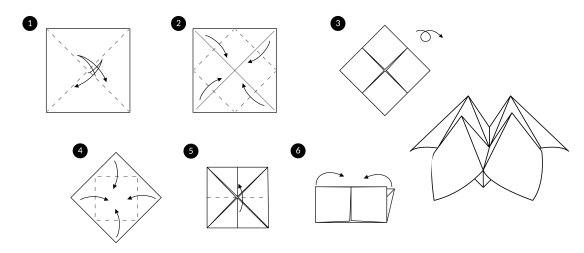By David Astle
“All my life, my heart has yearned for a thing I cannot name,” said Andre Breton, the French father of surrealism. Yet somehow I doubt the poet meant the origami whatsit that kids once played in the schoolyard. Still play, I’m told, under whatever name.
You’d recognise the gizmo the moment you see it. Several websites offer how-to-steps: take a square sheet of paper; fold each corner into the centre; now flip the smaller square and repeat. Next, poke your fingers into the four pouches and voila! You’ve made what Breton lacked his entire life, I think.
Of course, you must adorn the handiwork before playing. Colours or numbers are inscribed on each panel, allowing your victim to pick their fate. Blue – b-l-u-e. Or 5: 1-2-3-4-5. On reaching the lowest layer, you lift the destined flap to reveal a prophecy. You Will Marry Shane, say. Or Kylie Has A Crush On You. (“Oooh, lovers!” ).
Strong folds make for a strong chatterbox.Credit: Yuji Shimada
Thanks to such clairvoyance, the novelty is dubbed a fortune-teller by many, notably in Perth, and yesteryear Sydney. By contrast, Melbourne and Brisbane kids favour chatterbox, the default label for most millennial tweens. At least that’s the data emerging from my Twitter poll, but playgrounds are seldom so clear-cut.
Other names from other quarters, other eras, included fly-catcher (NZ), flea-catcher (Melbourne), lucky squares (Sydney), doodad (Bathurst), salt-and-pepper shaker (rural SA), snapdragon (Hunter Valley), clapper (Scotland), cootie-catcher (US) and tippy-tippy-tap (New Delhi).
One respondent Richard Norman knew the artefact as bada-bada. (“I went to a mildly oddball school, Canberra, mid-80s.”) Andre Serna, cutting his teeth in Palestine, called the doohickey a salt cellar. From her Bavarian girlhood, Michiko Weinmann recognised a Himmel und Hölle (heaven and hell).
Shades of Italy’s inferno-paradiso. Excepting in Bari, just above the boot’s stiletto, where the diversion is a becco di gallina (chicken’s beak), a plaything more prone to goosing its victims than providing future visions. As for France, try cocotte en papier (paper casserole) or un pouce-pouce (a thumb-thumb). Finding consensus on an object’s name has never been so evasive.

Need a refresh? Here’s how to make your own chatterbox. Credit: iStock
Unless we consider a liquidambar’s dooverlackie. Green and spiky, the pods go by a dozen different tags, most commonly bommy-knockers. Yet don’t exclude prickle bombs, war maces, bobbles, doobs, castor oils and spike berries. Gumballs rule in Washington DC, while conkers vanquished Great Britain. Comedian Alasdair Tremblay-Birchall, as a Canadian kid at Bega High, recalled, “Fresh pods were green dogs, dry ones were brown dogs, and the ones rolled in mud so they could be thrown harder – dirty dogs.”
Take you pick, since that’s the curse of multiple names. While an embarrassment of choices affirms an item’s appeal, the same extended menu can also steal a degree of identity. James Acaster, the English comedian, illustrated the point with “the pictures that you put your head in”.
Again, you know the novelty the minute you see one. Theme parks and carnivals will offer a pirate tableau, say, where a no-face Blackbeard, or hollow-headed parrot, await your inserted grin to be complete. Cassius Coolidge, the Quaker credited with creating the attraction in the 1870s, on top of his timeless poker-playing dogs, knew the contraptions as comic foregrounds, or photo stand-ins.
Cool, yet neither label stuck. Hence the avalanche of stopgap neologisms, including fauxtograph and tourist trap, hollow-gram and smugshot, impostor poster and twatstocks, storyhole and bored board, face-swap and Victorian VR. Glorious creations, one and all, yet the same list vouches for the object’s identity crisis, where multi-name status spells no-name in anybody’s language. In life, some thingummies are doomed, their popularity a form of anonymity.
A cultural guide to going out and loving your city. Sign up to our Culture Fix newsletter here.
To read more from Spectrum, visit our page here.